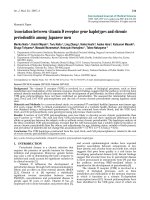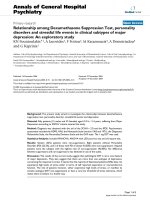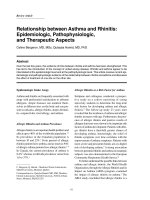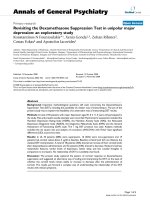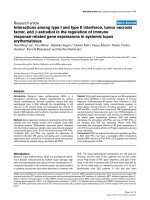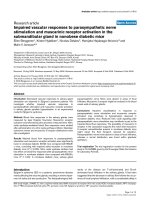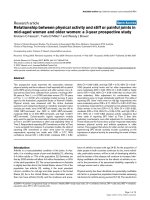Báo cáo y học: "Relationship among Dexamethasone Suppression Test, personality disorders and stressful life events in clinical subtypes of major depression: An exploratory study" pot
Bạn đang xem bản rút gọn của tài liệu. Xem và tải ngay bản đầy đủ của tài liệu tại đây (405.28 KB, 8 trang )
BioMed Central
Page 1 of 8
(page number not for citation purposes)
Annals of General Hospital
Psychiatry
Open Access
Primary research
Relationship among Dexamethasone Suppression Test, personality
disorders and stressful life events in clinical subtypes of major
depression: An exploratory study
KN Fountoulakis*
1
, A Iacovides
1
, F Fotiou
2
, M Karamouzis
3
, A Demetriadou
3
and G Kaprinis
1
Address:
1
Lab of Psychophysiology, 3rd Department of Psychiatry, Aristotle University of Thesssaloniki, Greece,
2
Lab of Clin Neurophysiology, 1st
Department of Neurology Aristotle University of Thesssaloniki, Greece and
3
Lab of Biochemistry, Aristotle University of Thesssaloniki, Greece
Email: KN Fountoulakis* - ; A Iacovides - ; F Fotiou - ;
M Karamouzis - ; A Demetriadou - ; G Kaprinis -
* Corresponding author
Depressionstressful life eventsstresspersonality disordersDexamethasone suppression test.
Background: The present study aimed to investigate the relationship between dexamethasone
suppression test, personality disorder, stressful life events and depression.
Material: Fifty patients (15 males and 35 females) aged 41.0 ± 11.4 years, suffering from Major
Depression according to DSM-IV criteria entered the study.
Method: Diagnosis was obtained with the aid of the SCAN v 2.0 and the IPDE. Psychometric
assessment included the HDRS, HAS, the Newcastle Scale (version 1965 and 1971), the Diagnostic
Melancholia Scale, the Personality Deviance Scale and the GAF scale. The 1 mg DST was used.
Statistical Analysis: Included MANOVA, ANOVA with LSD post hoc test and chi-square test.
Results: Sixteen (32%) patients were non-suppressors. Eight patients without Personality
Disorder (PD) (23.5%), and 5 of those with PD of cluster B (50%) were non-suppressors. Atypical
patients were the subtype with the highest rate of non-suppression (42.85%). No difference
between suppressors and non-suppressors was detected in any of the scales.
Discussion: The results of the current study suggest that pathological DST is not a core feature
of major depression. They also suggest that there are more than one subtypes of depression,
concerning the response to stress. It seems that the majority of depressed patients (50%) does not
experience high levels of stress either in terms of self reported experience or neuroendocrine
function. The rest of patients however, either experience high levels of stress, or manifest its
somatic analogue (DST non-suppression) or have a very low threshold of stress tolerance, which
makes them to behave in a hostile way.
Published: 14 December 2004
Annals of General Hospital Psychiatry 2004, 3:15 doi:10.1186/1475-2832-3-15
Received: 27 November 2004
Accepted: 14 December 2004
This article is available from: />© 2004 Fountoulakis et al; licensee BioMed Central Ltd.
This is an Open Access article distributed under the terms of the Creative Commons Attribution License ( />),
which permits unrestricted use, distribution, and reproduction in any medium, provided the original work is properly cited.
Annals of General Hospital Psychiatry 2004, 3:15 />Page 2 of 8
(page number not for citation purposes)
Background
Life events and environmental stressful factors may relate
to the development of depression [1-4]. However, biolog-
ical theories suggest that the cause of depression rely on a
biochemical disturbance of the functioning of the central
nervous system (CNS).
The Dexamethasone Suppression Test (DST) [5] is the
most known and worldwide used biological marker, its
results suggest that a disorder of the HPA axis is present in
at least some depressed patients [6]. DST non-suppression
is of unknown aetiology, and as a test is not specific to any
disease. Rather it constitutes an endocrin expression of
stress. Basically, DST is reported to assess norepinephrine
function. Topographically, it assesses the function of the
hypothalamus and indirectly of the structures, which
project to it. However, it is also supposed to be the result
of an increased serotonin (5-HT) or Ach activity, or of a
disturbance of the feedback to the hippocampus [7] and
the hypothalamus. A debate still holds, whether some
forms of depression are characterized by hypercorti-
solaimia or early escape from HPA tests. Possibly, DST
non-suppression and hypercortisolemia are two different
things [8].
The present study aimed to investigate the relationship
between dexamethasone suppression test, personality dis-
order (PD), stressful life events and clinical manifesta-
tions of major depression. The hypothesis to test was that
subtypes of depression could be identified on the basis of
the presence of personality disorder (which constitutes an
abnormal interpretation and response to environmental
stimuli), the presence of abnormal DST results and/or
hypercortisolemia (which both constitute an idiosyncratic
neuroendocrine response to stress) and the presence or
not of stressful life events (which trigger the above behav-
ioral and neuroendocrine responses).
The presence or not of Personality Disorder, and the
response to the DST are both characteristics of the patient.
Life events reflect the impact of the environment on the
patient. So, life events provoke responses from the side of
the patient, which are largely determined by Personality
and DST response. Thus, four groups of patients can be
identified and studied, according to the combination of
the co-existence of DST non-suppression and personality
disorder.
Material
Fifty (50) major depressive patients (15 males and 35
females) aged 41.0 ± 11.4 (range 21–60) years [9,10],
took part in the study. All provided written informed con-
sent. Fourteen of them fulfilled criteria for atypical fea-
tures, 16 for melancholic features (according to DSM-IV)
and 32 for somatic syndrome (according to ICD-10).
Nine patients did not fulfil criteria for any specific syn-
drome according either classification system.
Patients were in- or outpatients of the 3
rd
department of
psychiatry, Aristotle University of Thessaloniki, Greece.
They constituted consecutive cases that fulfilled the inclu-
sion criteria and no systemic bias exists.
The SCAN v 2.0 [11] was used for the diagnosis of depres-
sion and its subtypes and the IPDE [12-14] was used for
the diagnosis of personality disorders.
Seventeen patients (34%) suffered from a personality dis-
order (PD). Ten of them (20%) had a cluster B PD. Con-
cerning depressive subtypes, 5 (out of 16) melancholics
(26.32%), 7 (out of 14) atypicals (50%), 9 (out of 32)
patients with somatic syndrome (28.13%), and 3 (out of
9) 'undifferentiated' patients (33.33%), fulfilled criteria
for PD (note: patients with PD are not 5 + 7 + 9 + 3 = 24,
but only 17 as mentioned above, because there is ovelap-
ping between depressive syndromes). No patient suffered
from a paranoid, schizotypal, antisocial, dissocial, narcis-
sistic, and avoidant PD, although individual criteria were
met. No criteria belonging to the schizotypal or antisocial
PDs were met.
No patient fulfilled criteria for catatonic or psychotic fea-
tures or for seasonal affective disorder. No patient fulfilled
criteria for another DSM-IV axis-I disorder, excepting gen-
eralized anxiety disorder (N = 10) and panic disorder (N
= 7). Another 5 patients had both generalized anxiety dis-
order and panic disorder (totally 22 patients that is 44%
had some anxiety disorder).
The present study did not include a normal controls
group, since the aim of the study was to compare depres-
sive subtypes between each other.
Method
Laboratory Testing included blood and biochemical test-
ing, test for pregnancy, T3, T4, TSH, B
12
and folic acid.
The Psychometric Assessment included the Hamilton
Depression Rating Scale (HDRS), the Hamilton Anxiety
Scale (HAS), the 1965 and 1971 Newcastle Depression
Diagnostic Scale (1965 and 1971-NDDS) and the Diag-
nostic Melancholia Scale (DMS) [15] and the General
Assessment of Functioning Scale (GAF) [16]. An attempt
was made to assess the direction of aggression of the
depressed patients, with the use of the Personality Devi-
ance Scale (PDS) [17]. This was done mainly because the
direction of aggression is considered to be a core feature
for the etiopathogenesis of depression according to psy-
chodynamic theories, but also is related to personality
traits.
Annals of General Hospital Psychiatry 2004, 3:15 />Page 3 of 8
(page number not for citation purposes)
The PDS consists from the following subscales:
a. Extrapunitive Scale
(ES) which consists of 1. HT: Hostile
Thoughts and 2. DO: Denigratory Attitudes Toward other
People. All these scales and subscales are scored in such a
way that high scores denote lack of the characteristic.
b. Intropunitive Scale
(IS), which consists of 1. LSC: Lack
of Self-Confidence and DEP: Overdependency on Others.
All these scales and subscales are scored in such a way that
high scores denote presence of the characteristic.
c. Dominance Scale
(DS) which consists of 1. MIN: Dom-
ineering Social Attitude and 2. HA: Uninhibited Hostile
Acts. The MIN is scored in such a way that high scores
denotes presence of the characteristic, while HA has oppo-
site properties.
Data concerning personal and family history and stressful
life events
a. age of onset b. presence of a recent suicide attempt c.
history of such attempts d. The questionnaire of Holmes
[18] was used to search for stressful life events during the
last 6 months before the onset of the symptomatology.
The 1 mg Dexamethasone Suppression Test (DST) pro-
tocol demands the administration of 1 mg dexametha-
sone per os at 23.00 of the first day, and determination of
cortisol serum levels simultaneously and the next day at
16.00 and 23.00. Cortisol levels expressed in µg/dl were
measured with Luminance Immunoassay (intra-essay reli-
ability: 4.9%; inter-essay: 7.5%). Non-suppression cut-off
level: 5 µg/dl.
Statistical Analysis
Multiple Analysis of Variance (MANOVA) was performed
with DST (suppression vs. non suppression) and Person-
ality Disorder (present vs. absent) as factors. The depend-
ent variables list included: Age, Age of Onset, Number of
previous episodes, Number of DSM-IV Criteria, Number
of atypical features, Number of melancholic features,
GAF, NDDS 1965, NDDS 1971, Endogenous axis of DMS,
Reactive axis of DMS, Number of stressful life events,
HDRS-17, HDRS-21, HDRS Depressive index, HDRS Anx-
iety index, HDRS Sleep index, HDRS non-specific index,
HAS, HAS Somatic subscale, HAS Psychic subscale, PDS-
Hostile Thoughts Scale, PDS-Denigratory Attitude Scale,
PDS-Extrapunitive Scale, PDS-Low Self Confidence Scale,
PDS-Overdependency by others Scale, PDS-Intropunitive
Scale, PDS-Domineering Social Attitude Scale, PDS-Unin-
hibited Hostile Acts Scale and PDS-Dominance Scale.
Afterwards, Analysis of Variance (ANOVA) with Least Sig-
nificance Difference (LSD) test as post-hoc test was
performed.
Finally, Chi-square test was performed. PD and DST were
independently placed in cross-tabulation with the pres-
ence or absence of Recent Suicide Attempt, History of Sui-
cide Attempt, Generalized Anxiety or Panic Disorder,
Melancholic Features, Atypical Features, Somatic Syn-
drome, 'Undifferentiated' symptomatology, Full and sus-
tained remission, With Relapsing circumscribed episodes,
Chronic Depression without full remission, Presence of
Stressful life events, Family history of any mental disorder,
Family history of depression in 1
st
degree relatives, and
Family history of depression in 2
nd
degree relatives.
Results
Women were twice as many as men (70% versus 30%),
which is not uncommon [19] and reflects the higher prev-
alence of depression observed in women.
Sixteen out of 50 depressed patients (32%) were DST non-
suppressors (NS).
Eight out of 17 (47.05%) depressed patients with PD were
also NS.
When the patients with a coexistent personality disorder
(PD) were excluded, then 8 out of 33 (24.24%) patients
left, were NS.
When only cluster b PDs were excluded, the respected per-
centage of NS climbs to 27.5% (11 out of 40).
Fifty percent of Cluster b PD patients were NS (5 S and 5
NS).
Six out of 14 (42.85%) atypical patients were NS, and this
percentage makes this subtype the one with the highest
NS percentage.
No one of Chi-square tests revealed any significant find-
ings (at p > 0.01).
MANOVA results were significant both for Personality
Disorder (p < 0.001) and for DST (P < 0.001) (table 1).
ANOVA testing, separately for each dependent variable,
revealed significant findings concerning the number of
episodes, and HT, DO and HA subscales of the PDS.
When PD was used as the sole factor variable, significant
findings were found concerning the endogenous axis of
DMS and the HDRS depressive index. The interaction of
PD and DST produced significant findings concerning
age, age of onset, number of atypical features, number of
stressful life events, and the DO subscale of the PDS (table
2). Post-hoc comparisons for DST showed that NS were
more endogenous (1971-NDDS and DMS endogenous
axis) but with lower HDRS depressive index (p < 0.05).
Annals of General Hospital Psychiatry 2004, 3:15 />Page 4 of 8
(page number not for citation purposes)
Table 1: 2-way MANOVA results. Both Personality disorders and DST results and their interaction produce significant results.
Wilks' Lambda Rao's R df 1 df 2 p-level
Factors:
1-Personality Disorder (present vs. absent) and
2-DST results (suppressors vs. non-suppressors)
1 0.02 18.26 30 12 0.000
2 0.02 20.99 30 12 0.000
12 0.01 28.42 30 12 0.000
Table 2: ANOVA results for each dependent variable separately (only significant results are shown.
df Effect MS Effect df Error MS Error F p-level
Factors:
1-Personality Disorder (present vs. absent) and
2-DST results (suppressors vs. non-suppressors)
Dependent variable: age
1 1 93.29 46.00 103.25 0.90 0.347
2 1 80.23 46.00 103.25 0.78 0.383
12 1 935.13 46.00 103.25 9.06 0.004
Dependent variable: endogenous axis of DMS
1 1 9.08 46.00 8.26 1.10 0.300
2 1 78.71 46.00 8.26 9.53 0.003
12 1 21.10 46.00 8.26 2.55 0.117
Dependent variable
: age of onset
1 1 71.51 46.00 117.92 0.61 0.440
2 1 82.59 46.00 117.92 0.70 0.407
12 1 750.95 46.00 117.92 6.37 0.015
Dependent variable: number of episodes
1 1 17.46 46.00 2.11 8.28 0.006
2 1 0.48 46.00 2.11 0.23 0.637
12 1 0.31 46.00 2.11 0.15 0.703
Dependent variable
: number of atypical features
1 1 0.81 46.00 0.75 1.09 0.302
2 1 0.59 46.00 0.75 0.79 0.377
12 1 4.35 46.00 0.75 5.82 0.020
Dependent variable: number of stressful life events
1 1 10.45 46.00 3.27 3.20 0.080
2 1 4.87 46.00 3.27 1.49 0.229
12 1 19.51 46.00 3.27 5.97 0.018
Dependent variable: HDRS Depressive Index
1 1 1.47 46.00 7.04 0.21 0.650
2 1 44.23 46.00 7.04 6.29 0.016
12 1 4.01 46.00 7.04 0.57 0.454
Dependent variable
: PDS HT subscale
1 1 76.28 41.00 9.74 7.83 0.008
2 1 4.23 41.00 9.74 0.43 0.514
12 1 10.51 41.00 9.74 1.08 0.305
Dependent variable
: PDS DO subscale
1 1 44.95 41.00 10.11 4.44 0.041
2 1 10.27 41.00 10.11 1.02 0.319
12 1 40.50 41.00 10.11 4.01 0.052
Dependent variable: PDS HA subscale
1 1 97.48 41.00 13.12 7.43 0.009
2 1 7.91 41.00 13.12 0.60 0.442
12 1 30.77 41.00 13.12 2.35 0.133
Annals of General Hospital Psychiatry 2004, 3:15 />Page 5 of 8
(page number not for citation purposes)
Post-hoc comparisons for PD characteristics showed that
patients without PD had more previous episodes and less
hostile thoughts (HT) and less uninhibited hostile acts
(HA) (p < 0.05). The post-hoc results for the groups
defined by the interaction of PD with DST are shown in
table 3. A graphical representation of these results is
shown in figures 1 and 2.
DST suppressors without PD were older, with more severe
depressed mood and less atypical features (50% of
patients, figure 2, group A).
DST non-suppressors without PD were hypercortisolemic,
with less severe depressed mood and denigratory attitude
towards others (16% of patients, figure 2, group B).
DST suppressors with PD were younger, with younger age
of onset, more atypical features and less endogeneity and
more stressful life events (18% of patients, figure 2, group
C).
DST non-suppressors with PD had older age of onset, high
endogeneity and high levels of expressed hostility (16% of
patients, figure 2, group D).
Discussion
The current study reports that personality disorders (PD)
in depressed patients is 2.5–3 times higher in comparison
to the general population. Half (47.05%) of these PD
patients were also DST non-suppressors (NS). Atypical
patients was the depressive subtype with the highest fre-
quency of both personality psychopathology and DST NS.
Figure 2 represents a graphical image of the intercorrela-
tions between personality disorder, DST results and
clinical manifestations. It seems that there is a circular
relationship between PD, DST, age at interview, age of
onset, number of episodes, reactivity to environment,
hostility and depressed mood.
DST results seem to be a severity marker rather than
directly related to symptomatology. In patients without
PD, DST NS (group B in figure 2) may relate to milder
depressed mood, higher denigratory attitude and hostil-
ity, higher number of previous episodes and hypercortiso-
lemia. In patients with PD, non suppression (group D in
figure 2) was related to 'endogenous quality' of
depression, and higher levels of hostility. These patients
(group B) are highly hostile and perform uninhibited hos-
Table 3: Post-hoc comparison between the four diagnostic groups determined by DST results and the presence of personality disorder
concerning the continuous variables (Least Significance Difference-LSD Test).
Group A Group B Group C Group D
N = 25 (50%) N = 8 (16%) N = 9 (18%) N = 8 (16%) p p p p p p
Mean SD Mean SD Mean SD Mean SD A/B A/C A/D B/C B/D C/D
Age 44.90 9.55 34.00 10.89 33.78 8.96 40.57 11.63 0.005 0.002 0.168 0.964 0.241 0.173
Age of Onset 33.33 11.24 29.00 10.74 23.44 7.13 35.00 13.14 0.217 0.009
0.967 0.223 0.313 0.028
Number of Episodes 1.52 1.89 1.88 1.55 0.33 0.71 0.43 0.53 0.575 0.068 0.092 0.017 0.021 0.893
Number of atypical features 0.71 0.85 1.63 1.06 1.67 1.00 1.14 0.38 0.019
0.010 0.102 0.935 0.375 0.298
DMS Endogenous axis 4.33 2.29 5.88 1.89 2.11 2.52 6.57 4.28 0.217 0.032 0.155 0.004
0.754 0.018
Number of Life Events
reported
2.05 0.97 2.50 2.39 4.22 2.77 2.14 1.77 0.260 0.001 0.529 0.193 0.720 0.082
HDRS depressed index 11.43 2.38 8.50 2.14 10.22 3.87 8.86 2.79 0.005
0.350 0.014 0.282 0.837 0.378
HT 19.24 2.36 19.63 2.56 17.44 3.88 15.71 4.50 0.703 0.129 0.012
0.197 0.045 0.422
DO 13.00 3.16 9.88 3.44 13.11 2.57 14.14 3.63 0.028
0.927 0.431 0.043 0.036 0.515
HA 18.86 3.61 19.75 3.28 17.44 4.90 14.71 1.25 0.548 0.385 0.007
0.279 0.002 0.175
DST baseline cortisol value
(day 1, 23:00)
3.85 2.79 7.71 10.28 3.79 1.71 5.43 4.37 0.123 0.724 0.568 0.275 0.491 0.474
DST cortisol level at day 2,
16:00
1.40 1.13 6.81 7.91 1.34 0.98 4.84 5.32 0.002
0.973 0.001 0.057 0.584 0.047
DST cortisol level at day 2,
23:00
1.25 1.45 8.04 5.19 1.36 0.71 5.13 1.40 0.000 0.769 0.000 0.002 0.212 0.000
Group A: DST suppressors, no PD
Group B: DST non-suppressors, no PD
Group C: DST suppressors, with PD
Group D: DST non-suppressors, with PD
Annals of General Hospital Psychiatry 2004, 3:15 />Page 6 of 8
(page number not for citation purposes)
tile acts, however simultaneously have lower denigratory
attitude and hostile thoughts (possibly the hostility is
impulsive) and older age of onset.
Half of depressed patients belonged to the A group (sup-
pressors without PD), and were characterized by the
absence of atypical features. One could say that they rep-
resent a more 'formal' group of depressed patients. The
rest of patients were equally distributed in the three
groups (B, C and D). Groups B and C may represent two
distinct types of vulnerability to stress (hypercortisolemia,
DST non suppression and PD), while group D seems to
represent a more severe form of depression, with an
'autonomous' hostility independent from the environ-
ment. This severe type could be considered to be the prod-
uct of the accumulation of both vulnerabilities that
characterize groups B and C, with the addition of a very
low threshold for the tolerance of stress.
Nearly 4–10% of normal persons are reported to be DST-
NS. The reason for this is unknown, however it has been
suggested that it is due to an underlying mood disorder or
family history of affective disorder. Another explanation
suggests that DST reflects in fact the degree of psychologi-
cal pressure or discomfort of the subject and not a specific
vulnerability or characteristic of depression. It seems that
non-suppression is gradually increasing along a contin-
uum, which has mourning outpatients on the one pole
(13% NS) and severe psychotic melancholic inpatients
with psychotic features and suicidal ideation on the oppo-
site one (64% NS) [20]. In this frame, the percentage of
non-suppression reported in the current study (32%) is
not in contrast with the international literature, since
most of patients were out-patients and 16 of them (32%)
were melancholics. An important finding is the 42.85%
rate of non-suppression in atypical patients. This is
reported for the first time in the international literature.
DST NS and hypercortisolemia may constitute two sepa-
rate entities. For example, a patient may have baseline cor-
tisol equal to 6 µg/dl, second cortisol value equal to 2.5
µg/dl and third cortisol value equal to 5.5 µg/dl and thus
is classified as NS, but is not hypercorisolemic. On the
contrary, a patient with baseline cortisol value equal to 10
µg/dl, second value equal to 4 µg/dl and third also equal
to 4 µg/dl, is classified as NS, but is hypercorisolaimic.
Kirschbaum et al [21] reported that it is possible, some
normal control subjects do not manifest the hypercori-
solaimic response to stressful life events when these
events are repeated (habituation). They also divided
responses in high and low-cortisol responses. They related
the first group with low self-confidence, increased
depressed mood and higher number of symptoms, and
the second group with lower extraversion. Joyce et al [22]
suggested that the hypercortisolaimic response is related
to a tendency for dependence and extravagance. These are
generally in accord with the findings of the present study.
In contrast to what is widely accepted, NS is appeared to
be closer to the atypical subtype. There are no direct
reports in the international literature on this matter. How-
ever, the results of the study of Kocsis et al [23], in essence
are in accord with the current study.
Rothschild et al [24] related DST NS with increased
dopamine (DA) activity. Atypical patients, on the other
hand, when compared with melancholics, reported more
stressful life events, relatively higher levels of anxiety and
shorter brain potentials [25]. While it is not possible to
interpret what is the cause and what is the effect, it is inter-
esting that there are papers in the international literature
suggesting that conditions of internal conflict increase DA
activity and lead to the appearance of displacement activ-
ities, which in turn serve the lowering of the level of
arousal and stabilize the system [26]. Increased appetite,
food intake and weight gain (atypical features) could be
attributed to such a displacement activity. From the oppo-
site point of view, the exhaustion of DA storage is reported
to increase vulnerability to stress, because the already
hyperfunctioning neurons (DST non-suppression) fail to
respond properly [27]. According to Tazi et al [26], behav-
ioral analogues of the defensive mechanism of displace-
ment seem to suppress this procedure and in this way
contribute to the better copying with stressful situations.
Conclusion
Although the study sample of the current study is rela-
tively small, the results suggest that there are more than
one subtypes of depression, concerning the response to
Histogram of the Distribution of Frequencies of Depressive Subtypes in the Four GroupsFigure 1
Histogram of the Distribution of Frequencies of Depressive
Subtypes in the Four Groups
Annals of General Hospital Psychiatry 2004, 3:15 />Page 7 of 8
(page number not for citation purposes)
stress. The majority of depressed patients (50%) seems
not to experience high levels of stress both in terms of self
reported experience and neuroendocrine function. The
rest of patients however, experience high levels of stress,
either internally or have the somatic analogue of it (DST
non-suppression) or have a very low threshold of stress
tolerance, which makes them to behave in a hostile way.
Competing interests
The authors declare that they have no competing interests.
References
1. Paykel ES: The evolution of life events research in psychiatry.
J Affect Disord. Journal of Affective Disorders 2001, 62:141-149.
2. Paykel ES: Stress and affective disorders in humans. Seminaris in
Clinical Neuropsychiatry 2001, 6:4-11.
3. Iacovides A, Fountoulakis KN, Fotiou F, Kaprinis G: Relationship of
Personality Disorders to DSM-IV Subtypes of Major
Depression. Canadian Journal of Psychiatry 2002, 47:196-197.
4. Paykel ES: Life events, social support and depression. Acta Psy-
chiatr Scand Suppl 1994, 377:50-8.
5. Evans DL, Golden RN: The Dexamethasone Suppression Test:
A Review. In Handbook of Clinical Psychoneuroendocrinology Edited by:
Nemeroff CB and Loosen PT. New York, John Wiley and Sons;
1987:313-335.
6. Mendlewicz J, Hubain PP, Koumakis C: Further Investigation of
the Dexamethasone Suppression Test in Affective Illness:
Relationship to Clinical Diagnosis and Therapeutic
Response. Neuropsychobiology 1984, 12:23-26.
7. The APA Task Force on Laboratory Tests in Psychiatry: The Dex-
amethasone Suppression Test: An Overview of Its Current
Status in Psychiatry. American Journal of Psychiatry 1987,
144:1253-1262.
Characteristics of the four groups (white arrows in dark background indicate that the characteristic takes its largest or lower value in the respective group in comparison to all 4Figure 2
Characteristics of the four groups (white arrows in dark background indicate that the characteristic takes its largest or lower
value in the respective group in comparison to all 4.
Publish with BioMed Central and every
scientist can read your work free of charge
"BioMed Central will be the most significant development for
disseminating the results of biomedical research in our lifetime."
Sir Paul Nurse, Cancer Research UK
Your research papers will be:
available free of charge to the entire biomedical community
peer reviewed and published immediately upon acceptance
cited in PubMed and archived on PubMed Central
yours — you keep the copyright
Submit your manuscript here:
/>BioMedcentral
Annals of General Hospital Psychiatry 2004, 3:15 />Page 8 of 8
(page number not for citation purposes)
8. Halbreich U, Asnis G, Shindledecker R, Zumoff B, Nathan RS: Corti-
sol Secretion in Endogenous Depression, I: Basal Plasma
Levels. Archives of General Psychiatry 1985, 42:904-908.
9. American Psychiatric Associatrion: Diagnostic and Statistical
Manual of Mental Disorders, 4th Edition DSM-IV. Washington
DC, American Psychiatric Press; 1994.
10. WHO: The ICD-10 Classification of Mental and Behavioural
Disorders-Diagnostic Criteria for Research. Geneva, ; 1993.
11. Wing JK, Babor T, Brugha T: SCAN: Schedules for Clinical
Assessment in Neuropsychiatry. Archives of General Psychiatry
1990, 47:589-593.
12. WHO: International Personality Disorders Examination.
Geneva, ; 1995.
13. Fountoulakis KN, Iacovides A, Ioannidou C, Bascialla F, Nimatoudis I,
Kaprinis G, Janca A, Dahl A: Reliability and cultural applicability
of the Greek version of the International Personality Disor-
ders Examination. BMC Psychiatry 2002, 17:6.
14. Fountoulakis KN, Iacovides A, Kaprinis G, Ierodiakonou C: WHO:
International Personality Disorders Examination, Greek Edi-
tion. , 3rd Department of Psychiatry, Aristotle University of Thessa-
loniki Greece.
15. Bech P, , Berlin Heidelberg.: Rating Scales for Psychopathology,
Health Status and Quality of Life. Berlin Heidelberg., Springer
Verlag; 1993.
16. American Psychiatric Associatrion: Diagnostic and Statistical
Manual of Mental Disorders, 4th Edition, DSM-IV. Washington
DC, American Psychiatric Press; 1994:32.
17. Foulds GA, Bedford A: Hierarchies of personality deviance and
personal illness. British Journal of Medical Psychology 1977, 50:73-78.
18. Rahe R: Stress and Psychiatry. In Comprehensive Textbook of Psychi-
atry, 6th Edition Edited by: Kaplan HI and Sadock BJ. Baltimore, Wil-
liams and Wilkins; 1995:1545-1559.
19. Coryell W, Endicott J, Andreasen N, Keller M: Bipolar I, Bipolar II
and Non Bipolar Major Depression Among the Relatives of
Affectively Ill Probands. American Journal of Psychiatry 1985,
142:817-821.
20. Nelson C, Davis JM: DST Studies in Psychotic Depression: A
Meta-Analysis. American Journal of Psychiatry 1997, 154:1497-1503.
21. Kirschbaum C, Prussner JC, Stone AA, Federenko I, Gaab J, Lintz D,
Schommer N, Hellhammer DH: Persistent High Cortisol
Responses to Repeated Psychological Stress in a Subpopula-
tion of Healthy Men. Psychosomatic Medicine 1995, 57:468-474.
22. Joyce PR, Mulder RT, Cloninger CR: Temperament and Hyper-
cortisolemia in Depression. American Journal of Psychiatry 1994,
151:195-198.
23. Kocsis JH, Davis JM, Katz MM, Koslow SH, Stokes PE, Casper R, Red-
mond DE: Depressive Behavior and Hyperactive Adrenocor-
tical Function. American Journal of Psychiatry 1985, 142:1291-1298.
24. Rothschild AJ, Benes F, Hebben N, Woods B, Luciana M: Relation-
ships Between Brain CT Scan Findings and Cortisol in Psy-
chotic and Non-Psychotic Depressed Patients. Biological
Psychiatry 1989, 26:565-575.
25. Fotiou F, Fountoulakis KN, Iacovides A, Kaprinis G: Pattern-
Reversed Visual Evoked Potentials in Subtypes of Major
Depression. Psychiatry Res 2003, 118:259-71.
26. Tazi A, Dantzer R, LeMoal M: Schedule-induced Polydipsia Expe-
rience Decreases Locomotor Response to Amphetamine.
Brain Research 1988, 445:211-215.
27. Keefe KA, Stricker EM, Zigmond MJ, Abercrombie ED: Environ-
mental Stress Inceases Extracellular Dopamine in Striatum
of 6-Hydroxydopamine-Treated Rats: In Vivo Microdialysis
Studies. Brain Research 1990, 527:350-353.

